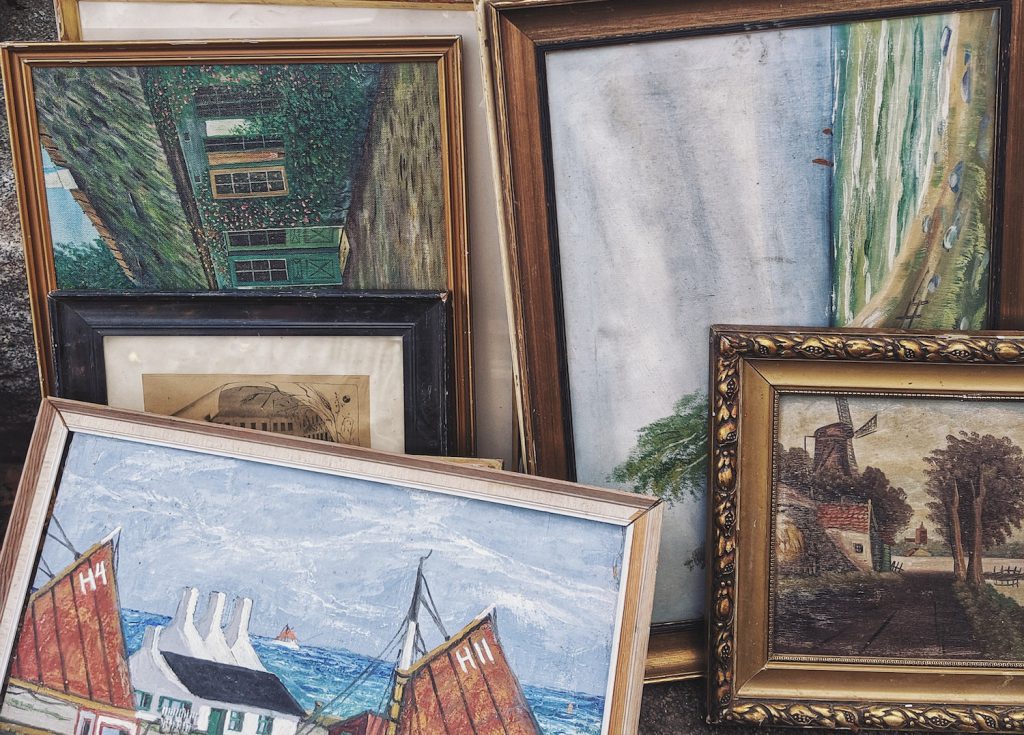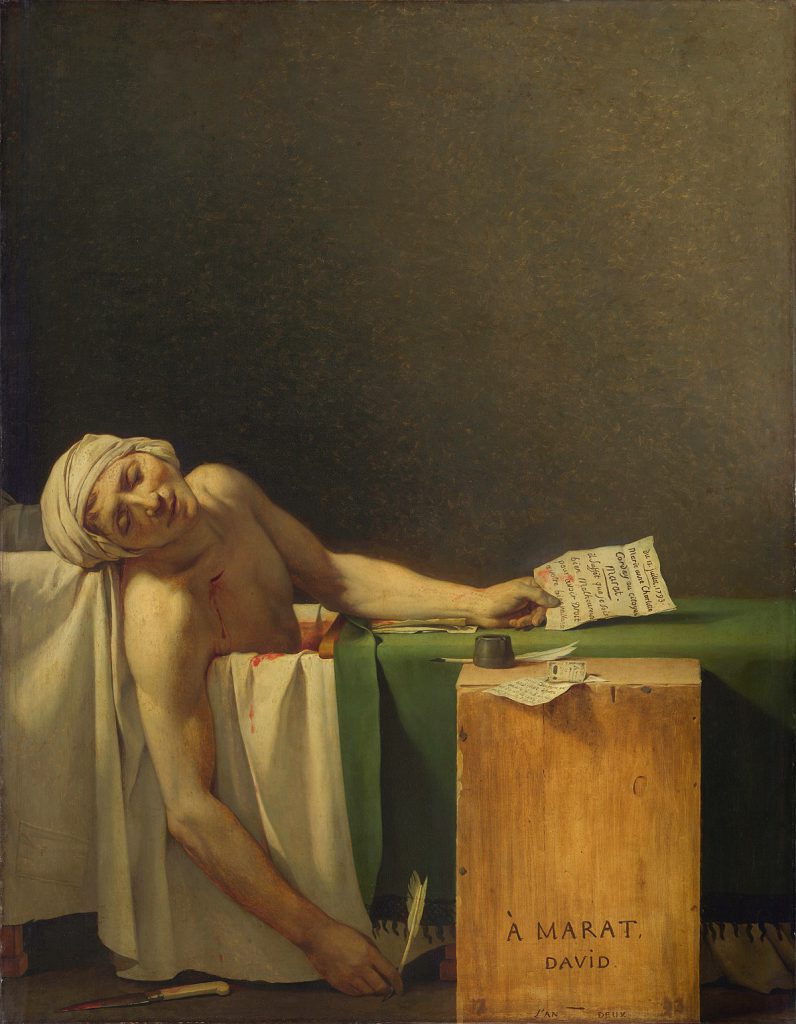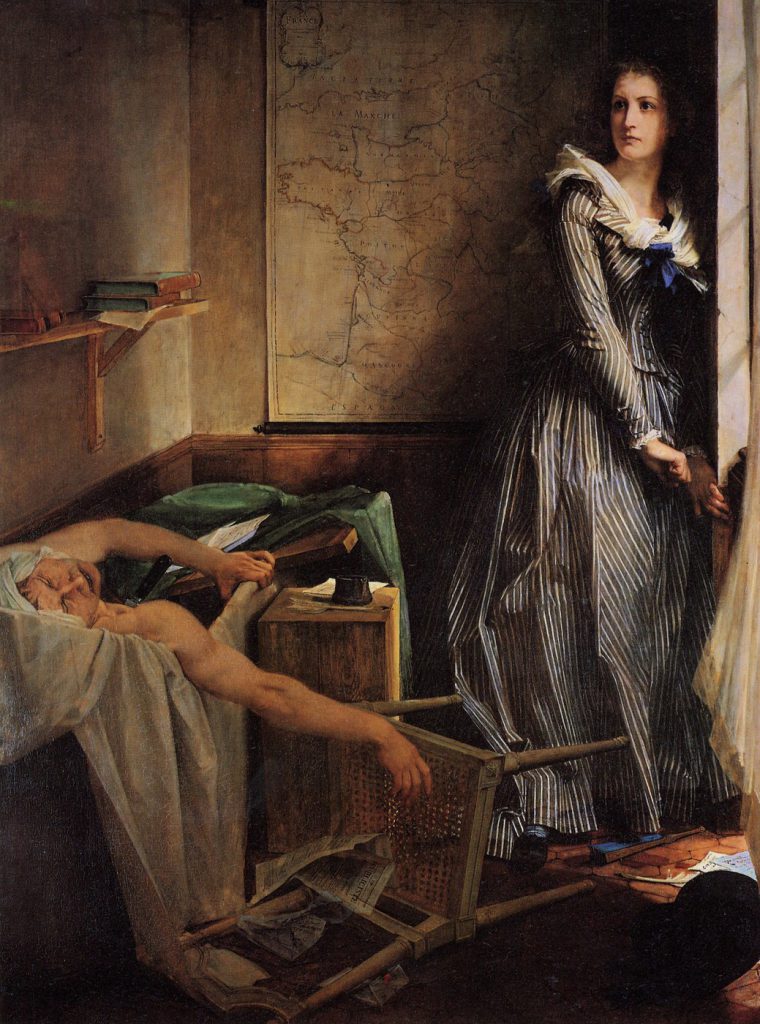How to Read a Painting: David’s The Death of Marat
by Charlotte Taylor

Imagine this: you’re planning a trip for your summer vacation. You meticulously plan out your itinerary — the restaurants you’ll enjoy, the self-guided walking tour you’ll embark on, or the museums you’ll visit. When you finally complete your sight-seeing and arrive at such museums, you find yourself surrounded by beautiful works of art that you’re told are amazing and that you ought to appreciate. So, you take the obligatory photo (or two) and you walk through the exhibit. Yet all the while, you find yourself utterly unprepared to appreciate these works of art as you feel you should. Yes, you know the Mona Lisa and Starry Night are some of the greatest paintings of Western art, but do you know why? Can you comprehend for yourself their beauty, or must you refer to the generic pamphlets of information? I found myself asking these questions upon my first few visits to major museums and encountering great art. Teaching students how to understand art by themselves, not just because they have been told to think a certain way, is something I’m immensely passionate about. I feel that the art history survey courses that UGA offers do a great job at teaching students how to think about art, not just what to think, and this essay attempts to capture that experience. Seeing and reading art is not a calculated science that applies the same formula to everyone — it is a unique combination of sensation, emotion, and intellectual analysis. But, I hope this essay may give an example of how I read this particular painting and act as a catalyst for your own desire to understand great art.
art, history, painting, Jacques Louis David, neoclassicism, French Revolution

Figure 1. David, Jacques-Louis. The Death of Marat. 1793. Royal Museum of Fine Arts, Belgium. Attribution: Jacques-Louis David, Public domain, via Wikimedia Commons. Link to image.
Jacques-Louis David’s painting of the death of prominent Jacobin and journalist Jean-Paul Marat immediately captures the viewer’s eye. However, this is not because of some obvious and blood-curdling horror. In fact, David minimizes the gruesomeness of the murder, making the wound a small, neat cut rather than a graphic, revolting gash. The carefully curated details of this picture which capture the violence that has taken place – from the scarlet bathwater to the bloody smudges across the paper in Marat’s hand – come second to a much more important aspect of this work. That is, the painting’s pause, its stillness immediately succeeding a grand act of inhumanity.
David completed this painting just a few months after Marat’s murder in July of 1793 and dedicated this piece to the journalist’s work for the Jacobin party during the French Revolution of 1789 to 1799. The Jacobins were a political club known for its revolutionary, left-wing politics during the French Revolution and its role in bringing about the Reign of Terror. As the revolution continued to escalate into the 1790’s, the Girondins emerged from the Jacobin club as a separate faction, taking on more right-wing, moderate beliefs and subsequently creating a rift in the National Convention, the governmental body of the revolution (Hanson 11). These tensions were exacerbated by the 1792 September prison massacres across Paris in which armed mobs attacked prisoners for fear that they would rise up from their jails and mount a counterrevolutionary force. The Girondins blamed their more radical counterparts for this violence and the National Convention was further divided. One such member of the Girondin party, Charlotte Corday, blamed Marat specifically, believing his influence was a threat to the welfare of the French Republic, and consequently committed this infamous murder (Hanson 11-12). David, a Jacobin himself, depicts the aftermath of Corday’s crime and uses simplicity of light, color, and composition to achieve a powerful image that serves as a preservation of Marat’s legacy in his life and work, as well as an allusion to Christian martyrdom to continue the progress of the French Revolution.
David uses a limited palette in this painting, with the dark brown of the background filling the bulk of the canvas. This darkness allows the subdued colors of the foreground to become more vivid, simultaneously achieving a somber and authoritative tone. The first thing you notice is Marat, draped in white from the turban on his head to the towels upon which his blood drips. This white recalls notions of virtue, purity, and morality and makes the horror of the bloody wound on his chest all the more potent. From there, you can follow Marat’s gaze and the curve of his arm downward to the left side of the painting where the bright orange, yellow, and brown tones of the wooden makeshift desk constitute the brightest spot in the whole picture. Behind it, the green cloth spread across the bathtub complements the red of Marat’s wound, while also dividing the lower half of the artwork into two sections of color. On the right, the green serves as a background, making the wooden box as prominent as possible and highlighting Marat’s life’s work as a writer; on the left, the white cloth frames the story of his death, told with the knife left on the floor and the stab wound. By splitting the canvas into parts, David tells the story of Marat’s life and death in one cohesive image, with a use of color that is not immediately apparent considering the overall muted tones.
David does something similar with light in the painting, keeping the upper half in darkness and illuminating the lower half in full detail. The pale, discolored skin of Marat’s corpse is only just noticeable, as David drapes it in warm, dramatic lighting that cuts across the lower half of the piece. From afar, the casual observer might even suppose that Marat is at peace, merely sleeping in his bath, until inching closer to the canvas and seeing the bloody wounds. The light illuminating Marat comes from an unknown source beyond the edge of the canvas, and its intensity and brightness suggest sunlight. Yet David does not include a window or any such light source within the frame, hinting that this is not a natural glow, but a heavenly one, shining down on Marat as it would on a saint and a martyr. This glow wraps around both the corpse and other objects in the canvas and makes a detailed background scene which stretches further into space unnecessarily because the dramatic highlights and shadows alone reveal the three-dimensional space. Instead, David has set the scene against a blank wall and achieve greater simplicity. As a result, Marat seems to burst out from the darkness of the background as a dramatic yet stoic image, which implies a position of sainthood and Christological allusion as one who died for the cause of his people.
Despite such a simple composition, David fits so much detail of the story into this work — from the writing materials that indicate Marat’s radical journalism, the cause of both his renown and death, to the bloodied knife left on the floor. He does not leave anything unclear, even labeling the wooden box in the foreground in large letters as belonging to Marat, simultaneously clarifying who is the subject and ensuring the preservation of Marat’s name over the course of the French Revolution and history. There can be no question of who or what is being depicted here.

Figure 2. Baudry, Paul Jacques Aime. Charlotte Corday. 1861. Rmn-Grand Palais, Paris. Attribution: Paul-Jacques-Aimé Baudry, CC0, via Wikimedia Commons. Link to image.
However, David goes beyond mere intelligibility. The story of this painting extends beyond the tragedy of the murder itself because while David carefully paints the body of Marat and the murder weapon, the murderess is excluded from the piece. We do not see her triumphing in the success of her plot or even villainized by David for her gruesome deed. For example, Paul Jacques Aime Baudry’s 1860 version of this story places Charlotte Corday as the primary focus, with her face illuminated and Marat left to the shadows. Baudry tells the story of Corday and her infamous deed with drama – the overturned chair, Marat’s left hand still clutching the edge of the bathtub, and the stern, remorseless look of the killer.
David chooses to omit her presence entirely. Her agency, motives, and planning do not play a significant role in the painting as David shifts his attention beyond eliciting a generalized, emotional reaction to a murder from his audience. This, then, cannot be a mere retelling of events, or a factual record for posterity; rather, it is a dedication and an immortalization of a hero. David continues to emphasize this notion through the simple details of this piece; he paints the knife cast aside on the floor, obscured in the shadow cast by Marat’s body, symbolizing his triumph over death. He lives on through the legacy of his writings and the continued path of the French Revolution. In fact, the quill in Marat’s right hand seems to stand in direct opposition to the knife just beside it, as the knife is abandoned and useless, its power lessened after momentary use, while the quill lies in the clutches of its owner even after his death. In this way, David highlights the strength and enduring presence of Marat’s words and ideas over temporary passion and emotion.
Fittingly, this celebration of reason and intellect mirrors the opposition between the Neoclassical style that David exemplifies and the decadent sensuality of the Rococo in previous decades. Neoclassicism arose in the eighteenth and nineteenth centuries as a reaction to the shallow and ornamental style of the Rococo, which flourished among the aristocracy of France. This art sought to be decorative, embellishing salons and living spaces, and most subject matter that it dealt with fell within the categories of pastoral scenes and garden parties, often with an erotic tone. Instead, Neoclassical art sought to return to the compositional simplicity and moralizing messages of ancient Greek and Roman art. As Jean Cailleux in her essay on the development of Neoclassicism in France puts it, “By the end of the century, the taste of the time demands austerity; people aspire to the Republic; the art turns to the illustration of virtue. Painting is no longer an amusing pastime, it is made to elevate the soul and force people to think. Its function is moral as well as political” (vii). David exhibits that moral function just so. The room surrounding Marat is not adorned with sensational artwork or patterns, and the towels and furniture that surround him are not luxurious materials; rather, David merely paints a darkness, an emptiness, that emphasizes the figure below to an even greater degree, among his simple linens and wooden box. The merit of the work lies in details such as the placement of Marat’s body, which evokes imagery of the Pietà, the depiction in Christian art of the Virgin Mary cradling Jesus’ body after his crucifixion. For David, it is enough to reference Christian ideology broadly without directly citing a biblical subject in order to create a moralizing tone within the painting (Cailleux vii). The overall simplicity of the work strikes at the heart of the Neoclassical style and emphasizes Marat’s virtue as a man whose value emerged from the content of his mind, not the dressings of his body.
By placing Marat in the context of his work for the French Revolution, David reaffirms the cause of his death – his advocacy for the party of the Jacobins and the people of France. Thus, it becomes even more important that this death be avenged through a continuation that cause Marat died for, so making his martyrdom worthwhile. In order to motivate that continued allegiance and devotion to the revolutionary cause, David designs a composition that elevates Marat and the tragedy of his death. This is most obvious in the arrangement of his corpse, as the weight of Marat’s body causes his arm and head to tilt over the edge of the bathtub, heavy with the burden of this sacrifice. By referencing the Pietà, the painting replicates imagery of Christ’s crucifixion and subsequent deposition and transforms a gruesome murder into a call to action and a motivation for perseverance. David does not merely depict Marat’s murder in this painting, but both the events preceding and the events to follow, telling the story of his life and the symbol of the revolution he was to become.
Works Cited
Cailleux, Jean. “Aspects of Neo-Classicism in France.” The Burlington Magazine, vol. 115, no. 840, The Burlington Magazine Publications Ltd., 1973.
Hanson, Paul. “A To Z of the French Revolution.” Scarecrow Press, 2007.
Acknowledgements: To my professor, Dr. Andrew, for inadvertently convincing me to take the leap and switch my major to art history. And to my sister, for always being by my side, even from four thousand miles away.
Citation Style: MLA